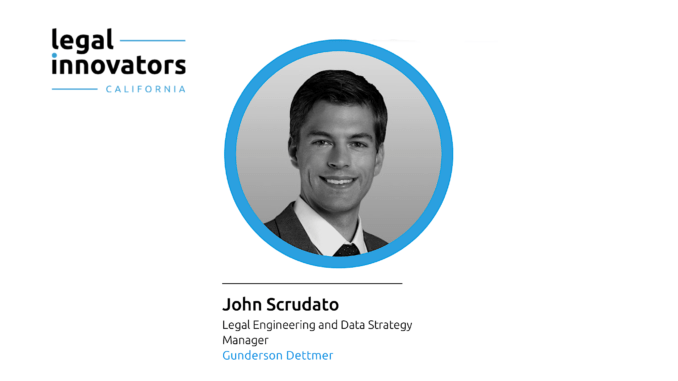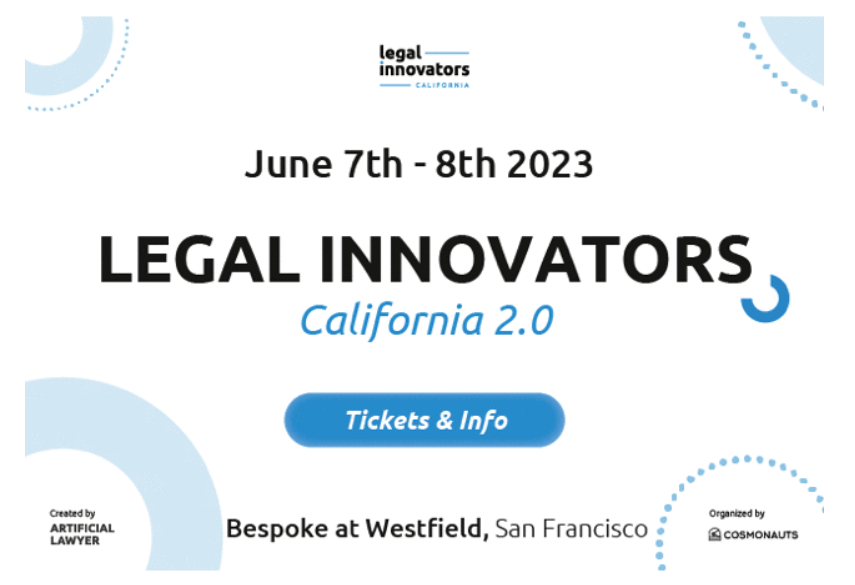
This week’s Legal Innovators California Profile is with John Scrudato, Legal Engineering and Data Strategy Manager at Gunderson Dettmer, the leading US law firm well-known for its experience in the technology and venture capital sectors.
John will be speaking at the landmark legal innovation conference in San Francisco on June 7 and 8. For more details please see here.
—
– When did you first hear the term ‘legal innovation’ and what did you think at the time?
Probably sometime in 2017. At the time, I was a young lawyer at Gunderson Dettmer and was interested in seeing what lessons from manufacturing and operations could be applied to the practice of law. I was aware of legal operations, but legal innovation as a distinct function was almost non-existent.
It was clear to me then that the types of efficiency and value-enhancing analyses I studied in business school – things like value-based accounting, enterprise resource planning, value stream mapping, etc. – were impractical or impossible in many parts of the legal industry because there was so little visibility into the internal operations of legal organizations and so little data to analyze.
Mentions of ‘legal innovation’ caught my attention as a means to an end – a way of making the invisible, visible. I took it to mean the practice and study of deploying technology and practices to create the conditions for a broader deployment of automation and analytics within legal. At first, I think there was a lot of smoke and not much fire. We saw lots of announcements for new ‘innovation’ initiatives and teams forming, but it didn’t feel like the everyday experience of actual lawyers was changing all that much.
Subsequent developments – both technological and social – have opened up opportunities and created rapid changes I never dreamed of, even just a couple of years ago. It’s getting easier and easier analyze natural language like contracts with computers, and forces like the pandemic and work-from-home radically shifted people’s expectations for when and where it’s appropriate to use technology – hint, almost everywhere and all the time. At the same time, the enabling technologies required to effect change experienced a step function in their capabilities. Today, it’s not uncommon for young lawyers to have access to AI-powered internal search tools, rich KM databases curated by experts and enhanced by AI, and increasingly sophisticated document automation tools.
– What is your role now?
I am the Legal Engineering and Data Strategy Manager at Gunderson Dettmer. My core role is to identify, evaluate, and integrate (sometimes build) practice-facing technology into our firm’s tech stack so we can leverage the data generated in our data stack. I help make sure everything speaks the same language and that the work done in one legaltech tool enables insights and reduces work in other parts of our platform. I also represent Gunderson in the Open Cap Table Coalition – a coalition of law firms and software companies developing an open-source data standard for company capitalization data – as the chair of the Technical Working Group developing the data standard.
– Why did you move into this field?
I co-founded a start-up back in 2011. One of the things I took away from that experience was that the legal mechanisms people relied upon to build and run companies were way behind the digitized, connected experiences people were coming to expect in other service industries like banking, accounting or tax.
I went to law school in part because I wanted to find a way to bring some of the innovations and forward-thinking ethos from the startup world into the legal world, and I knew next to nothing about the legal profession. ‘Legal Innovation’ and ‘legal engineering’ as vocations didn’t really exist back in 2016, as they’ve only really developed in the last five years. I was vaguely aware of legal operations and interested in learning more about that. I ultimately decided to join Gunderson Dettmer as a first-year associate as I really enjoyed my summer associateship here and felt working with a tech-focused client base would let me play to my strengths and leverage my operations and engineering background.
It was largely thanks to my interest in finding a cross-over between technology and law that I stumbled across the nascent legaltech community in New York. Whenever I could, I tried to meet people who were interested in using technology to improve legal service delivery. I was lucky to have a chance meeting with Christian Lang at the Global Legal Hackers summit in 2017.
Christian would go on to found the amazing NY Legal Tech Meetup, and I was an enthusiastic early supporter and attendee from the start – I helped arrange for Gunderson to host the meetup’s first Demo Day at Grand Central Tech in 2017. Through that community, I was able to meet a lot of like-minded people at a time when legaltech barely registered for most VCs and law firms.
This shifted slowly at first and then, around 2018/2019, with the sudden breakthrough success of a lot of first-generation practice management and legal AI tools, faster and faster. When I had an opportunity to join Latham & Watkins in 2019 to focus on legal innovation full time as a ‘Legal Innovation Attorney’, I jumped at it and never looked back.

– What is the most rewarding aspect of your job?
I get to use bleeding edge technology in one of the least tech-forward parts of the U.S. economy to try to future proof it. Every day is a new challenge, but every challenge leads me to new tech and new solutions . More than the technology, though, I’ve enjoyed the opportunity to work with like-minded peers at startups and other law firms. A lot of the challenges to change management in law are fundamentally not technological but rather due to the nature of practice.
Lawyers are busy and naturally skeptical. To the extent they might be open to wiz-bang promises, they often lack the time to indulge that interest. Legal innovation professionals are tasked with sorting through all of the hype and half-baked solutions and trying to deliver actual value for attorneys and clients. There’s a lot of collaboration in the legal innovation world, and it’s been really rewarding helping to build organizations like the Open Cap Table Coalition to try to solve industry-wide problems.
– If you looked into a crystal ball, how much do you think the everyday practice of law would change in the next five to ten years, especially given changes in AI?
It’s going to change dramatically for transactional attorneys and for litigators who spend most of their time doing drafting work – briefs, memoranda, etc.. The technology to manipulate and search natural language – or what passes for it in the law 😉 – is developing extremely quickly. Preparing boilerplate, searching for precedent, and drafting documents is going to get dramatically faster and easier.
Related analytical tooling to catch drafting errors, improve drafting quality and cross-check that documents are consistent with other documents or statutes will become increasingly sophisticated. I expect relationships and human interaction will become much more important and new attorney training will have to become much more intentional and rely less on the sheer quantity of their billable hours.
– What are the biggest challenges legal innovation now faces in the current climate?
In a lot of ways, the challenges are the same, but I think people’s perception of them have probably changed. As legal innovation become an established function in law firms, I noticed that many firms tried to approach it with the same mindset they had for traditional software procurement. They would look for purpose-built, off-the-shelf ‘solutions’ that solve discrete problems. This old-school enterprise software acquisition lifecycle strongly influenced the types of tools that were likely to survive the gauntlet of the acquisition process. It often leads firms to products that checked enough boxes to be interesting yet could still be easily walled off and which attorneys and users could be trained on in isolation. This model doesn’t work.
As a lot of my peers in this space can attest, getting attorneys to ‘train’ themselves on new software is a real challenge, and, the more time required to master it, the less likely it is they’ll actually use something. I’ve found the most impactful innovations are those that can run behind the scenes or fit into existing workflows. Law firms need to put in the time to figure out how to create surgical integrations into existing systems and how to leverage the data and insights in those systems. That means developing internal competencies to perform analytics and collect the data most relevant to their specific practices and needs. If the current climate means having less money to throw after off-the-shelf solutions in favor of more time and determination to find ways to integrate technology seamlessly into the day-to-day business of the firm, I think that’s good for all of us.
– And what are the greatest opportunities now for change across the legal sector?
The cost of extracting computer-readable data from legal documents is approaching $0. It’s becoming increasingly feasible to build digital models of complex, human systems like regulatory regimes, contractual obligations, etc.. Legal experts, working in tandem with software engineers and AI experts, will be able to surface insights into the interactions of these large-scale systems that will likely be extremely valuable to Fortune 500s and sophisticated legal consumers.
The most successful law firms in the near future will successfully merge best-in-class analytics and modeling with best-in-class legal expertise to solve complex problems. On the opposite side of this coin, it’s going to get easier and easier for would-be entrepreneurs to create half-baked solutions that look amazing at first but fall-down in ways that may not be obvious initially. Innovation teams need to be well-versed in how the AI and NLP space is developing and what pitfalls to look out for.
– And finally, what advice would you give to anyone wanting to get into the field of legal innovation and legal tech?
Any concrete advice I could offer on learning a specific skill or tool will probably be out-of-date in a year or two. First principles are going to be more important than ever as the industry enters a period of rapid change. Any aspiring lawyer’s or legal technologist’s lodestar needs to be a deep understanding of the purpose of the law and the missions of the systems and organizations that developed in service of it. All of the forms, rules and traditions that exist in our world developed to provide a consistent set of rules we can all live our lives by and to help individuals and companies navigate that system, comply with it, and use it to their collective benefit.
Obviously we don’t always live up to those ideals, but I believe they are still the ultimate reasons why we all go to work every day. These principles will ultimately guide us in identifying where the law and the legal system fail, where they succeed, and where we most urgently need to change them. I believe winning careers and products in this space will be those built with the humility to respect what’s come before but the vision to deploy technology in service of those underlying principles.
—
Thanks John! Looking forward to hearing you speak at Legal Innovators California, June 7 and 8 in San Francisco.
If you would like more information about the two-day event in San Francisco, please see here. Day One will focus on law firms and ALSPs, and Day Two will focus on inhouse and legal ops.
To get your tickets and book your place at the landmark legal innovation conference in San Francisco this June please see here.
See you all there!

1 Trackback / Pingback
Comments are closed.